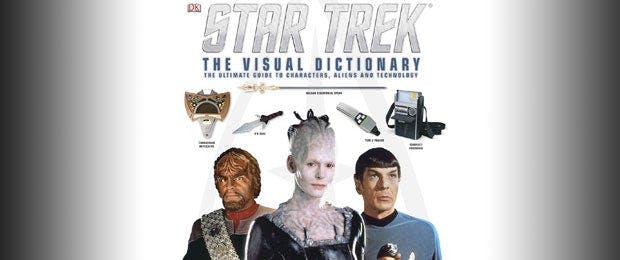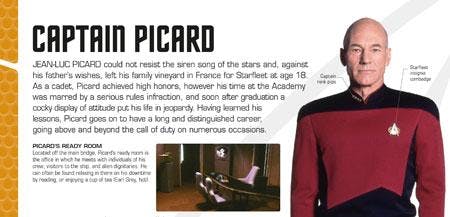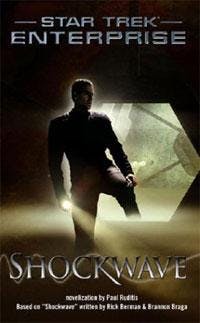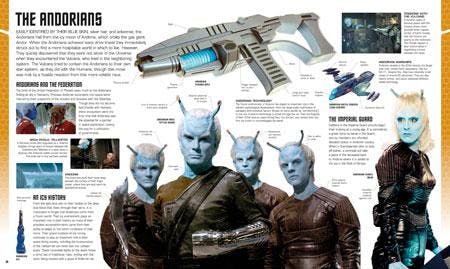Published Mar 7, 2013
Exclusive Interview: Visual Dictionary Author Paul Ruditis
Exclusive Interview: Visual Dictionary Author Paul Ruditis

We’ve been teasing Star Trek The Visual Dictionary for a few months now, sharing preview pages and tipping fans off about a contest to win free copies of the DK tome, which is a visual exploration of the Star Trek universe, spanning all five of the Star Trek series (and the first 10 feature films) and veering from A (for Andorians) to V (for Vidiians). Well, it’ll be out on March 18, and today we’re pleased to present an interview with the book’s author, Paul Ruditis.How did the opportunity to write Star Trek The Visual Dictionary come about for you?Ruditis: CBS Consumer Products very kindly suggested me for the book. It was one of those rare, wonderful situations where I woke up one morning to find an email from an editor I’ve never met before offering me a job. That’s a really nice way to wake up. How well do you know Star Trek? Were you a fan? If so, which shows/movies, characters/ships do you personally like most?Ruditis: I’d say I’m fairly familiar with Star Trek. My father started me watching the reruns of the original series when I was really, really young. He used to try to convince my mom it was the monsters on Sesame Street giving me the nightmares, not the Gorn. I didn’t really become a fan though until The Next Generation came out when I was a teen. That’s when I truly understood what Star Trek was about, so I’d say that’s the series I connect with the most.

What of the more obscure elements of the Star Trek universe did you love, that you were eager to write about? And what elements did you maybe not know, that intrigued as you did your research for the project?

ence, it’s not like you’re going to suddenly fill every page with Tribbles simply because they’re kids. I’ve found that children interested in Star Trek already tend toward a more mature reading level anywre so many other topics to cover that we couldn’t find a way to justify doing it. I was glad I got to explore more of Star Trek: Enterprise. I sort of fell off watching that series shortly after I wrote the “Shockwave” novelization. I regretted that since I knew they explored a lot of the mythology of the Star Trek universe in the later seasons of the show. Since that mythology was so important to writing this book, it gave me a reason to reconnect with Enterprise. Speaking of research, what did you use as your resources to keep it all within the Trek canon?Ruditis: Well, it all starts with the show itself. Thankfully everything is available on Netflix now, because my old VHS tapes are totally warped to the point the episodes are beyond recognition. I also have so many of the wonderful official reference books on my shelf that any time I had a question, there was a resource to confirm or contradict what I already knew…or didn’t remember correctly.You're writing for a younger audience. How did you go about finding the right tone to your prose, so that it spoke to the reader, not at him or her?Ruditis: I’ve written a lot for children and teens -- one of the reasons I suspect CBS suggested me -- and I’ve never found this to be a problem. I don’t really think about it too much. It’s just a matter of knowing your audience and what their interest is in picking up this book. Children’s interests are just as diverse as adults, so the tone has to fit with that diversity. When you’re talking about a Star Trek visual dictionary that is geared toward a younger audience, it’s not like you’re going to suddenly fill every page with Tribbles simply because they’re kids. I’ve found that children interested in Star Trek already tend toward a more mature reading level anyway.

What was the process? Were you handed photos and then went off and wrote about them, or did you also have a hand in choosing what Trek elements were covered in the book.Ruditis: It started with DK sending me an outline that covered pretty much every page of the book. I tweaked the outline to add things that I felt were more important and remove things I didn’t consider crucial information. When you’re putting together a visual book that covers over seven hundred hours of television and movies, it’s impossible to include everything. There has to be some give and take in choosing the importance of a subject. Once we came up with the outline, CBS had some additional input then I set about pulling the photos.

Selecting the photography was quite intensive. The design of the book is a bit like a puzzle in finding the right pieces to fit together and then hoping the images are a good quality and properly represent the topic. I’m sure there will be a lot of questions of why we focused on a certain character over another in the visuals and it usually comes down to the fact that the image fit a variety of needs for the section.Once the images were selected, DK designed the pages so that I’d know how much text was needed to fill in around the pictures. Every single entry had to meet a fairly specific word count or else it would alter the design of the pages. How ready are you for fans to get their hands on Star Trek The Visual Dictionary?Ruditis: I can’t wait. I was talking with the John Van Citters at CBS about the book back at the beginning of the project and he summed up the project best. He’s got all these great Star Trek reference books in his office, but he can’t really share them yet with his youngest son. The Star Trek Encyclopedia, for example, is a fantastic reference book that I have used many, many times over the years, but you’re not necessarily going to hand that to a small child for some light reading. The Visual Dictionary can be a good way to introduce his son to Star Trek, beyond the episodes themselves, of course. I hope other parents can use it for that purpose as well.


